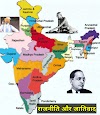Nuclear Fission and Fusion Explained
Introduction:
Nuclear fission and fusion are fascinating phenomena that delve into the very core of atomic structures, unleashing enormous amounts of energy. In this blog, we will explore the definitions, processes, and examples of nuclear fission, compare it to nuclear fusion, and touch upon the intriguing realm of atomic fission and fusion reactions.
Nuclear Fission Defined:
Nuclear fission is a process where the nucleus of an atom splits into two or more smaller nuclei, accompanied by the release of a significant amount of energy. This phenomenon is typically induced by bombarding a heavy nucleus, such as uranium-235 or plutonium-239, with a neutron. The resulting split nuclei, called fission products, release additional neutrons, initiating a chain reaction.
Nuclear Fission Process:
The process begins with a neutron colliding with a heavy nucleus, causing it to become unstable and split into two or more smaller nuclei, along with a few neutrons. This chain reaction continues, producing a substantial release of energy. The most notable example is the nuclear fission reactions occurring in nuclear power plants, where controlled chain reactions generate electricity.
Examples of Nuclear Fission:
1. Uranium-235 Fission: U-235 undergoes fission when bombarded with neutrons, releasing energy and additional neutrons.
2. Plutonium-239 Fission: Pu-239, another fissile material, can sustain a chain reaction, contributing to both energy production and nuclear weapons.
Difference Between Nuclear Fission and Fusion:
While both fission and fusion involve releasing nuclear energy, they differ fundamentally. Nuclear fission splits heavy atomic nuclei, producing energy, while fusion combines light nuclei, releasing even more energy. Fission is utilized in nuclear power plants, whereas fusion powers the sun and hydrogen bombs. Fusion reactions require extremely high temperatures and pressure to overcome the repulsive forces between positively charged nuclei.
Nuclear Fission Reactor:
Nuclear fission reactors harness the energy released during fission to generate electricity. Controlled fission reactions within a reactor core produce heat, which is then used to generate steam, driving turbines connected to generators. This technology plays a crucial role in meeting global energy demands.
Atomic Fission and Fusion:
Atomic fission and fusion are broader terms encompassing both nuclear and chemical reactions. Atomic fission refers specifically to the splitting of atomic nuclei, while atomic fusion involves the combination of atomic nuclei. Nuclear reactions release far more energy compared to chemical reactions, offering vast potential for both beneficial and destructive applications.
Conclusion:
Nuclear fission, with its controlled energy release, has become a cornerstone of modern energy production. Understanding the distinctions between fission and fusion provides insights into the diverse applications and implications of nuclear reactions. As we continue to explore and harness the power within atomic nuclei, advancements in nuclear technology promise both challenges and opportunities on the horizon.
Also Read:











0 Comments